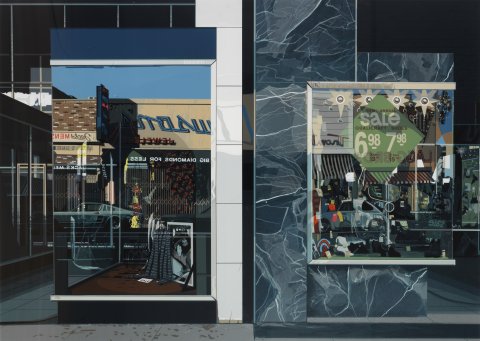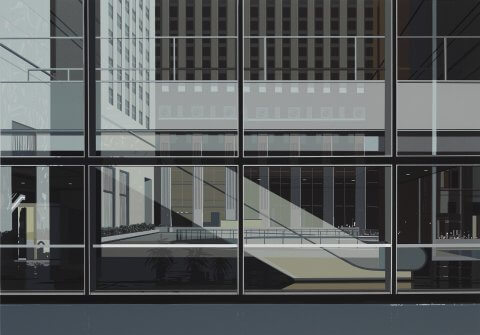
“ In Holland Hotel I can think of no significance in my choice of location or subject other than the fact it struck me as visually interesting. The contrasting styles of architecture, the orange hues late in the afternoon. The diagonal construction of the shop window thrusting the perspective in different directions’.

Qualicraft Shoes, 1974, Screenprint in colours
Richard Estes, born 1932 in Kewanee, Illinois, is regarded as one of the founders of the international photo-realist movement of the late 1960s. Having studied at the prestigious Art Institute of Chicago, he moved to New York City in 1956 and worked for the next ten years as a graphic artist for various magazine publishers and advertising agencies. By 1966 he had the financial resources to devote himself full time to painting and by 1971 to printmaking.
Most of Estes’ paintings from the early 1960s are of city dwellers absorbed in everyday activities. From the late sixties, Estes began to engage with the architecture of the city, with strong geometric views of storefronts, shopping malls, skyscrapers, offices and restaurants. These works, so typical of Estes’ practice, trapped the evanescent nature of reflections, which encapsulate these civic scenes.

Manhattan, 1981, Screenprint in colours
His Urban Landscapes series exemplifies his fascination with the ‘modern city’ as well as his fluency in printmaking. His highly polished technique of rendering a ‘photographic’ view through print was one he first mastered in 1971. In preparing an image for screenprinting, Estes follows a highly sophisticated process, creating templates in gouache and acrylic, which in turn are photographed. The photographed template is then used to create stencils employed in the laborious screenprinting process. The complexities of many of his images, which utilise a vast number of colours and tonal modulations make the proofing process extremely time consuming but the result is one of acute observation and accuracy, exemplifying Estes’ mastery of the medium. Working from photographs has also allowed Estes to achieve an extra-sensory effect, producing highly organised compositions and views, which are meticulously planned before being printed.
Estes’ work can be seen in major collections around the world, including the Art Institute of Chicago, Hirshhorn Museum and Sculpture Garden, Washington, Museum of Modern Art, New York, Neue Galerie der Stadt Aachen, Ludwig Collection, Aachen, Germany; Solomon R. Guggenheim Museum, New York and the Whitney Museum of American Art, New York.
